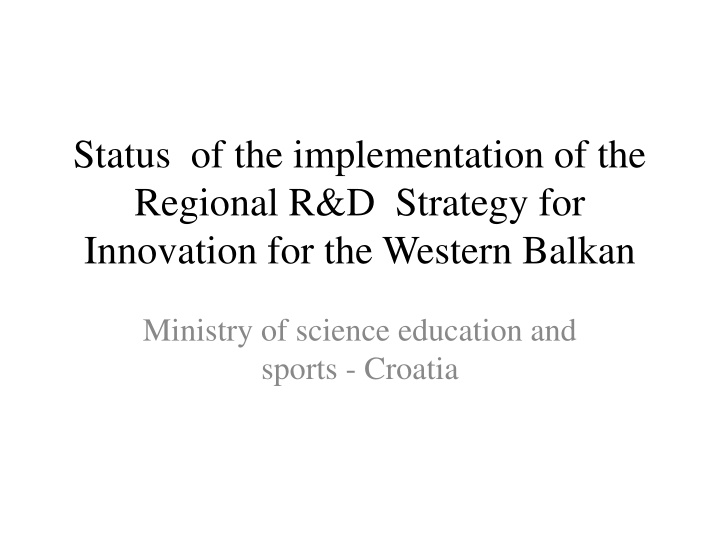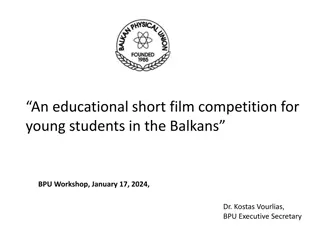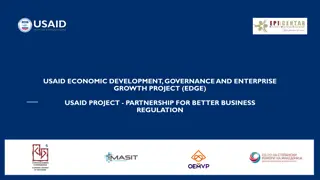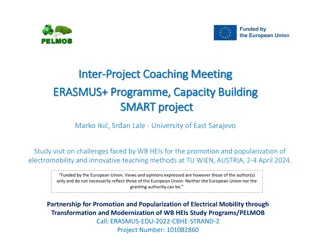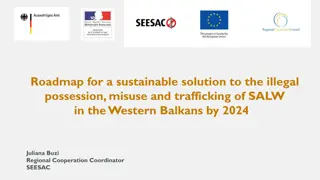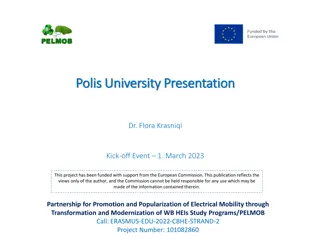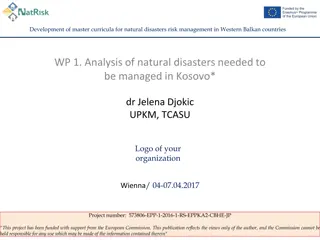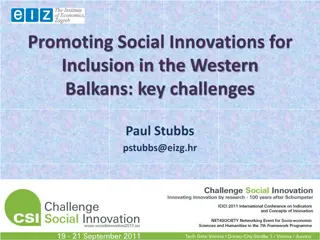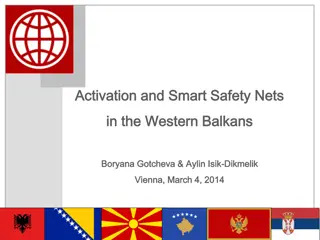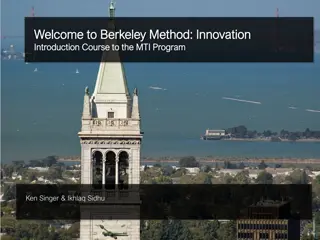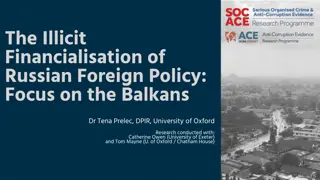Status of R&D Strategy for Innovation in Western Balkans
The Regional R&D Strategy for Innovation in the Western Balkans was adopted in 2013, focusing on the impact of R&D and innovation, investment trends, research performance, and set goals till 2020 to enhance research and innovation in the region.
Download Presentation

Please find below an Image/Link to download the presentation.
The content on the website is provided AS IS for your information and personal use only. It may not be sold, licensed, or shared on other websites without obtaining consent from the author.If you encounter any issues during the download, it is possible that the publisher has removed the file from their server.
You are allowed to download the files provided on this website for personal or commercial use, subject to the condition that they are used lawfully. All files are the property of their respective owners.
The content on the website is provided AS IS for your information and personal use only. It may not be sold, licensed, or shared on other websites without obtaining consent from the author.
E N D
Presentation Transcript
Status of the implementation of the Regional R&D Strategy for Innovation for the Western Balkan Ministry of science education and sports - Croatia
25th and 26th of October 2013 - the Regional R&D Strategy for Innovation for the Western Balkan was adopted in Zagreb by the ministers of science from the region during the ministerial meeting on regional R&D.
The Impact of R&D and Innovation in the Western Balkans Innovative firms grow faster: 15 percent faster (in sales) and 8 percent faster in labor productivity than non-innovative firms. Firm R&D expenditures significantly contribute to performance: raises sales (by 12 percent) and labor productivity growth (by 6 percent) on average in the Western Balkans (without Croatia). When firm R&D, training and infrastructure services sales are compared, R&D is shown to have the highest correlation to sales growth (excluding Croatia) Source: Seker, M. (2013) Background paper for the technical assistance on the Western Balkans R&D for Innovation Strategy
The Western Balkans Investment in R&D Gross expenditure on R&D in the WB has declined dramatically in the past two decades. The region is investing approximately 495 million in the R&D per year The variance of R&D intensity within the region The regions R&D intensity 0,33 % of GDP Western Balkans invest in R&D less than would have been expected after controling for development (income) levels
Research and Technology Transfer in WB Scientific performance substantially bellow EU average The average number of citation per document in the Western Balkans is 0.62 in comparison average in EU 27 is 1,27 for the period 2003-10 Science - industry collaboration ranking of 144 countries, the WB s average stands at the 88th position (EU27- 40th)
Four goals till 2020 Based on suggestion to set a target for R&D intensity to 1.5 % of BDP by 2020 for WB in average 4 goals are set Improve the research base and conditions for research excellence Promote collaboration and technology transfer between research institutions and industry Enable business innovation and innovative start-ups Strengthen the governance of research and innovation policies
Achieving the goals There has to be two leveles of action: Policy reforms Strategic investments Result: Growth, Competitiveness good jobs
Improve the research base and conditions for research excellence To slow down the brain drain increased investment in human capital To improve access to modern research facilities and availability of research funds To eliminate biases against young researchers To attract talented young researchers, scientific diaspora To base career progress on assessment of research impact and technology transfer and teaching achievements
Promote collaboration and technology transfer between research institutions and industry To improve incentive regime for collaboration between research institutions and private sector To rationalize access to and to enhance the performance of science and technology parks and incubators
Enable business innovation and innovative start-ups To reform investment climate factors particularly relevant to young and innovative start-ups To improve access to innovation financing and mentoring services To support the international integration of young and innovative firms
Regional Programs 1. A research excellence fund to increase international collaboration with the scientific Diaspora and expand opportunities for young researchers. 2. Regional networks of excellence in selected fields consistent with a strategy for smart specialization of the region. 3. A technology transfer facility to support and provide assistance at national level 4. An early stage innovation facility to complement the support to be provided by the Western Balkan Enterprise Development and Innovation Facility (EDIF). The Western Balkans Innovation Strategy Exercise (WISE)
Action plan for regional cooperation Expected outputs Expected outcomes 80 international collaboration research projects funded 50 young researchers projects funded 200 PhDs in science from leading universities Contributed to improving the research base and conditions for research excellence Slowed brain drain Research excelence fund
Expected outputs Expected outcomes Large number of joint publications in high impact factor journals Increased mobility of reaserchers Increased collaboration in business Improved research base and conditions for research exvellence Investment in hman capital Networks of Exellence Program
Expected outputs Expected outcomes 10 TTO developed and 100 stuff trained 100 joint projects between research and industry 3 technology parks restructured 3 new parks created Promoted research and industy collaboration and technology transfer Improved acces to and performance of technology and science Improved technology parks Technology transfer program
Expected outputs Expected outcomes 300 proof of concept and prototypes tested 100 business plans and bankable projects prepared Enable business investmnt in research and innovation and start-up creation Create more knowledge based start-ups Increase investment in start-ups Early stage start-up Program
Regional Technical Assistance Facility Small and not-for profit organization with strong emphasis on result orientation and rigorous evaluation two main components: Technical assistance and capacity building Program design, monitoring and evaluation Facility will design, monitor and evaluate the four proposed programs
Next steps To achieve consensus on memorandum of understanding and host count agreement To organize science forum and the signing of memorandum and agreement To establish financial plan for next period of implementation To focus on the further implementation at least two of proposed projects in the next period
Thank you www.mzos.hr miljenka.kuhar@mzos.hr
